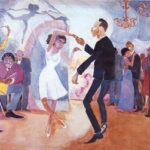A flurry of activity took place in the history of African-Americans in the 1950’s and 1960’s. The Civil Rights movement was propelled by violence against blacks, political marginalization, and continued segregation. One of the cases which compelled many whites and blacks to join the Civil Rights movement was the violent lynching of Emmet Till in Mississippi.
Understanding Black History: Mississippi – A Hotbed of Racism and Violence
Mississippi was among the southern states where particularly racism and violence grew particularly vehement. White leaders in Mississippi are credited with creating the WCC, White Citizen’s Council, in an attempt to thwart integration efforts. Murder of blacks was commonplace and more often than not law enforcement turned a blind eye to such hate crimes.
Understanding Black History: Who is Emmett Till?
Emmet Louis “Bobo” Till was born to Louis and Mamie Till on Chicago’s South Side, July 25, 1941. At age 14, he headed to Mississippi to visit his great uncle Moses Wright. Moses lived near Money, Mississippi.
A few days after Emmett arrived in Mississippi he and several other teenagers went into Money, to Bryan’ts Grocery and Meat Market. The general store was owned by Roy and Carolyn Bryant, whose customers were primarily black sharecroppers.
Understanding Black History: Emmett’s “crime”
Emmet whistled at Carolyn Bryant after she sold him candy. His teen behavior, innocent if immature, cost Emmet Till his life. Going to Mississippi from Chicago Emmett, nor his mother, had any idea of the extent and violence associated with racism.
Understanding Black History: White Vengeance and Fury
Three days later, August 28, 1955, Roy Bryant and his half-brother J.W. Milam visited Moses’ Wright’s home in the early morning. Around 2:30am the men broke into Wright’s home and kidnapped Emmett Till.
Following the incident Emmett Till went missing. Roy Bryant and J.W. Milan were arrested on kidnapping charges. The two told authorities that they had only talked to Emmett and released him.
Understanding Black History: The Truth of Emmett Till’s Murder
Three days later, August 31, a boy fishing in the Tallahatchie River discovered Emmet Till’s decomposed corpse. Emmet’s neck was wrapped in barbed wire tied to a 75 pound metal fan of a cotton gin. One eye dangled from his head and a bullet was lodged in his skull. His body was easily identified by a ring he wore, which he had inherited from his father that bore the initials L.T.
Understanding Black History: The Importance of the Media in Forging Social Justice
The body was returned to Chicago, where Mamie Till waited for her young son’s body at the Illinois Central Terminal. Mamie collapsed at the sight of the casket. Photographers and reporters are on hand to record the dramatic return of Emmett’s body.
Southern newspapers label the crime “brutal and senseless,” but accuse blacks of rabble rousing by calling the murder a “lynching.” Papers in six European countries pick up the story of Emmett Till’s lynching in Mississippi. His story drew more attention than the atrocious murders that had taken place before his because he was only 14 years-old.
Mamie Till, grieved and furious, held an open casket funeral. It is estimated that 50,000 viewed the body. Additionally, Jet magazine photographed the mutilated body and published the photos. African-Americans all over the U.S. were outraged.
Understanding Black History: Acquittal for Whites, a Common Theme
As if the crimes against the young black child were not enough, the straw that broke the camel’s back in the Emmett Till lynching occurred when Moses Wright and Willie Reed identified Emmett Till’s killers in court, yet the two were acquitted
When released for deliberation, the jury took only one hour and seven minutes. Roy Bryant and J.W. Milam were acquitted. The white men in Mississippi embraced their wives and broke out cigars in celebration.
Understanding Black History: Emmet Till becomes a Martyr for the Civil Rights Movement
Meanwhile, blacks and whites alike were so moved by the heinous crime against Emmet Till that money and membership in the Civil Rights movement began to increase. Momentum was beginning to build in a movement that was determined to establish social justice and equality for all.
Additional outrages over the next few years would continue to spark the development and direction of the Civil Rights Movement.
The Emmett Till murder was revisited by filmmaker Keith Beauchamp in The Untold Story of Emmett Louis Till. Clips from the Emmet Till case accompanied by a song can be viewed on Youtube.
Sources:
“Death of Emmett Till,” Youtube.com
“Early Civil Rights Struggles: The Murder of Emmett Till,” www.watson.org
“Emmett Till”
“The Murder of Emmet Till: The Brutal Killing that Mobilized the Civil Rights Movement,” American Experience, PBS.com



